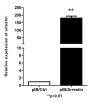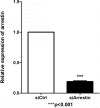Functional characterization of an arrestin gene on insecticide resistance of Culex pipiens pallens
- PMID: 22768923
- PMCID: PMC3425237
- DOI: 10.1186/1756-3305-5-134
Functional characterization of an arrestin gene on insecticide resistance of Culex pipiens pallens
Abstract
Background: Continuous and excessive application of insecticides has resulted in the rapid development of insecticide resistance in several mosquito species, including Culex pipiens pallens. Previous studies in our laboratory found that arrestin gene expression was higher in the deltamethrin-resistant (DR) strain than in the deltamethrin-susceptible (DS) strain of Cx. pipiens pallens. Similarly, other studies reported that arrestin was highly expressed in permethrin-resistant Cx. quinquefasciatus and in dichlorodiphenyltrichloroethane (DDT)-resistant Drosophila melanogaster.
Methods: Full-length cDNAs of an arrestin gene were cloned from Cx. pipiens pallens via polymerase chain reaction (PCR) and rapid amplification of cDNA end (RACE). The mRNA levels of the arrestin gene in the whole life cycle of DR and DS strains of Cx. pipiens pallens were investigated via quantitative real-time PCR. In addition, the relationship between arrestin and deltamethrin (DM) resistance were identified using genetic overexpression strategies and arrestin RNAi in mosquito cells. Cell viability was analyzed with cholecystokinin octapeptide after DM treatment. Moreover, the mRNA levels of cytochrome P450 6A1 (CYP6A1) and opsin in the transfected cells and controls were analyzed.
Results: Complete arrestin gene sequence was cloned and expressed throughout the life cycle of Cx. pipiens pallens. Moreover, arrestin was significantly upregulated in the DR strain, compared with that in the DS strain at the egg, pupae, and adult stages. Arrestin overexpression comparably increased the mosquito cell viability, whereas arrestin knockdown by siRNA decreased mosquito cell viability with deltamethrin (DM) treatment. Meanwhile, the mRNA levels of CYP6A1 and opsin were upregulated in mosquito cells transfected with arrestin and downregulated in mosquito cells with arrestin knockdown.
Conclusion: This study presented the first evidence that arrestin might be associated with insecticide resistance in Cx. pipiens pallens.
Figures









Similar articles
-
The cuticle proteins: a putative role for deltamethrin resistance in Culex pipiens pallens.Parasitol Res. 2015 Dec;114(12):4421-9. doi: 10.1007/s00436-015-4683-9. Epub 2015 Sep 4. Parasitol Res. 2015. PMID: 26337265
-
Venom allergen 5 is Associated With Deltamethrin Resistance in Culex pipiens pallens (Diptera: Culicidae).J Med Entomol. 2015 Jul;52(4):672-82. doi: 10.1093/jme/tjv059. Epub 2015 May 29. J Med Entomol. 2015. PMID: 26335474 Free PMC article.
-
Lipase is associated with deltamethrin resistance in Culex pipiens pallens.Parasitol Res. 2020 Jan;119(1):23-30. doi: 10.1007/s00436-019-06489-2. Epub 2019 Nov 23. Parasitol Res. 2020. PMID: 31760499
-
Pyrethroid resistance in Culex pipiens mosquitoes.Pestic Biochem Physiol. 2015 May;120:68-76. doi: 10.1016/j.pestbp.2014.12.018. Epub 2014 Dec 19. Pestic Biochem Physiol. 2015. PMID: 25987223 Review.
-
Phenotypic insecticide resistance status of the Culex pipiens complex: a European perspective.Parasit Vectors. 2022 Nov 12;15(1):423. doi: 10.1186/s13071-022-05542-x. Parasit Vectors. 2022. PMID: 36369170 Free PMC article. Review.
Cited by
-
Unveiling the Role of Two Rhodopsin-like GPCR Genes in Insecticide-Resistant House Flies, Musca domestica.Int J Mol Sci. 2024 Oct 2;25(19):10618. doi: 10.3390/ijms251910618. Int J Mol Sci. 2024. PMID: 39408947 Free PMC article.
-
NYD-OP7/PLC regulatory signaling pathway regulates deltamethrin resistance in Culex pipiens pallens (Diptera: Culicidae).Parasit Vectors. 2018 Jul 16;11(1):419. doi: 10.1186/s13071-018-3011-5. Parasit Vectors. 2018. PMID: 30012184 Free PMC article.
-
CYP-mediated permethrin resistance in Aedes aegypti and evidence for trans-regulation.PLoS Negl Trop Dis. 2018 Nov 19;12(11):e0006933. doi: 10.1371/journal.pntd.0006933. eCollection 2018 Nov. PLoS Negl Trop Dis. 2018. PMID: 30452436 Free PMC article.
-
Multiple-P450 Gene Co-Up-Regulation in the Development of Permethrin Resistance in the House Fly, Musca domestica.Int J Mol Sci. 2023 Feb 6;24(4):3170. doi: 10.3390/ijms24043170. Int J Mol Sci. 2023. PMID: 36834582 Free PMC article.
-
Genome wide population genetics and molecular surveillance of insecticide resistance in Anopheles stephensi mosquitoes from Awash Sebat Kilo in Ethiopia.Sci Rep. 2025 May 12;15(1):16443. doi: 10.1038/s41598-025-95814-0. Sci Rep. 2025. PMID: 40355632 Free PMC article.
References
-
- Gubler D, Jeffery JAL, Thi Yen N, Nam VS, Nghia LT, Hoffmann AA, Kay BH, Ryan PA. Characterizing the Aedes aegypti Population in a Vietnamese Village in Preparation for a Wolbachia-Based Mosquito Control Strategy to Eliminate Dengue. PLoS Negl Trop Dis. 2009;3(11):e552. doi: 10.1371/journal.pntd.0000552. - DOI - PMC - PubMed
-
- Smith DR, Adams AP, Kenney JL, Wang E, Weaver SC. Venezuelan equine encephalitis virus in the mosquito vector Aedes taeniorhynchus: infection initiated by a small number of susceptible epithelial cells and a population bottleneck. Virology. 2008;372(1):176–186. doi: 10.1016/j.virol.2007.10.011. - DOI - PMC - PubMed
Publication types
MeSH terms
Substances
Grants and funding
LinkOut - more resources
Full Text Sources
Miscellaneous

